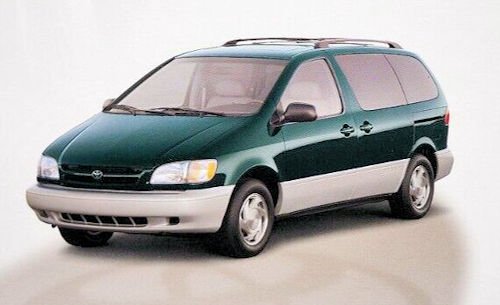Toyota Sienna 1st Generation
 |
|
|
Model code |
XL10 |
|
Model years |
1998–2003 |
|
Assembly |
United States |
|
Layout |
Front-engine, front-wheel-drive |
|
Engine |
3.0 L 1MZ-FE V6 |
|
Power output |
194–210 hp (145–157 kW; 197–213 PS) |
|
Transmission |
4-speed A540E/A541E automatic |
|
Wheelbase |
2,900 mm (114.2 in) |
|
Length |
|
|
Width |
1,860 mm (73.4 in) |
|
Height |
1,710 mm (67.3 in) |
|
Curb weight |
1,802 kg (3,973 lb) |
The Toyota Sienna is a MPV van that is manufactured since the end of 1997 by the Japanese car manufacturer Toyota in the US exclusively for the American market. This is based on the revised platform of the Camry . In the US, he was the successor of the Previa of the 1st generation. It has a more conventional front-wheel drive design than its predecessor and was revised and enlarged in 2004. The Sienna is often seen as a large-capacity taxi in New York .
End of 1997 Toyota brought the front-wheel drive Sienna as a model in 1998 on the North American market and replaced the more advanced to Previa with its mid-engine rear-wheel drive. The Sienna was unveiled with a Toyota 1MZ-FE 3.0-liter V6 engine that produced 197 bhp (145 kW) and 284 Nm of torque. It was built on the extended platform of the Camry and therefore marketed as "Camry under the Vans". The Sienna also proved to be the vehicle with the lowest fuel consumption in its class; it consumed 14.9 l / 100 km in the city and 10.9 l / 100 km on the highway. The cars were built at Toyota Motor Manufacturing Kentucky , Georgetown, Kentucky . One year after its introduction, the Sienna grew up in the new Honda Odyssey a serious competition.
With the model year 2001, the Sienna was slightly revised. This received a small facelift on the front and rear. A new grille-headlight combination and new taillights with white turn signal covers gave it a more modern look. A revised centre console made it possible to better control the heating and ventilation, as well as the electrically operated sliding doors. The engine received a variable valve timing which increased its power to 210 bhp (154 kW) and its torque to 298 Nm.
Sienna's well-designed cabin has a low floor foreasy entry or exit Second-row occupants lose valuable leg space with the seats in front pushed back as with the third row.A column-mount transmission lever allows full front-to-rear walkthrough. Most controls are convenient .The middle roof pillars
and rear headrests impede driver vision somewhat. The interior has bins and drink holders of various sizes but Removing the heavy middle or rear seats is more of 2-person job.
This generation received a particularly good safety rating. At the time, the Sienna was the only van to offer side airbags and stability control (VSC) on request. ABS was delivered as standard. Sienna received a rating of "good" in all six front impact tests in the Insurance Institute for Highway Safety (IIHS) investigations
|
Crash Test Ratings of NHTSA (1999) |
|
|
Front impact driver: |
5 Stars |
|
Front impact passenger: |
5 Stars |
|
Side impact driver: |
4 stars |
|
Side impact passenger: |
5 Stars |
Technical
-
STANDARD EQUIPMENT:
CE: 3.0-liter dohc V-6 engine, 4-speed automatic transmission, driver- and passenger-side air bags, anti-lock brakes, tire pressure warning system, daytime running lights, front air conditioning (3-door), front and rear air conditioning (4-door), variable-assist power steering, tilt steering wheel, cloth reclining front bucket seats, console with storage, overhead console, 2-passenger second-row seat, 3-passenger split-folding third row seat, cupholders, AM/FM/cassette, digital clock, visor mirrors, auxiliary power outlets, variable intermittent wipers, rear intermittent wiper/washer, automatic headlights, tinted glass, dual outside mirrors, 205/70R15 tires, wheel covers.LE adds: front side-impact air bags, front and rear air conditioning, power front windows, power door locks, power mirrors, cruise control, rear defogger, tachometer, rear privacy glass, full-size spare tire.
XLE adds: power driver seat, power rear quarter windows, heated power mirrors, AM/FM/cassette/CD player, quad captain's chairs, leather-wrapped steering wheel, illuminated visor mirrors, remote keyless entry, floormats, roof rack, theft-deterrent system, 215/65R15 tires, alloy wheels.
-Note: More Specifications and Repair Manuals available for registered users-
© Motor car History
